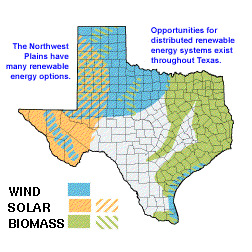|
Texas is blessed with abundant renewable energy resources. In
fact, Texas' solar, wind, and biomass potential rank among the very
best in the nation. As summarized in Figure 18 below, many areas of
the state have sufficient Rcommercial qualityS resources to support
large investments such as electric power production, cogeneration,
and alcohol manufacturing, as well as multitudes of distributed,
small-scale projects. Texas' excellent endowment suggests that
renewable energy offers exceptional potential to help meet the
state's future energy needs.

FIGURE 18. Areas of high Solar, Wind, and Biomass Potential.
Striped areas indicate more than one good resource
Development of the state's renewable energy resources could
provide meaningful employment opportunies and stimulate local
economies. The Northwest Plains, with sizable wind, solar, and
biomass potential, is well positioned to reap rural economic benefits
associated with the growth of renewables. In the urban areas of East
and Central Texas, distributed renewable energy systems can satisfy a
large portion of local energy needs. In addition, many renewable
energy sytems mesh synergistically with efforts to control various
wastes. Examples include distributed electric generation facilities
fueled by landfill gas and other urban wastes, and solar ponds
constructed in conjunction with facilities that prevent saline water
from contaminating fresh water supplies.
This project has gathered information from a wide variety of
sources. In total, these sources determine that Texas has plentiful
renewable resources. But in order to optimally utilize the renewable
energy resource base of the state, additional information will be
required. The recommendations which follow are designed to provide a
better understanding of resources that have the potential to make
significant near-term contributions towards the state's energy needs.
Future investments in renewable energy resource assessment should
be focused in areas where they are expected to have the greatest
near-term impact, and secondly when and where opportunities present
themselves to participate in other ongoing resource assessment
activities.
1) Building Climatology: Characterize the state's building stock
and examine the potential impact of passive strategies. Building
structures that are more in tune with their environmental
surroundings makes sense economically. However, passive strategies do
not operate independent of one another; additional validation of
optimal strategies for structures built in Texas climates is
warranted.
2) Wind: Establish more wind monitoring stations throughout the
state. Secondly, evaluate wind data that are already available. The
recent interest in wind energy development in the state has motivated
the need for additional resource information, particularly in windy
areas. The numerous existing wind data that have not yet been
considered should be evaluated.
3) Solar: Establish more solar monitoring stations throughout the
state, particularly in the Trans-Pecos and along the Rio Grande. The
best solar resource areas of Texas have almost no measured solar data
available. Major solar development will require substantially
improved resource information to reasonably locate facilities.
4) Biomass: Fully participate in federally sponsored programs.
Although active in certain areas such as switchgrass field trials,
Texas researchers have been absent from other assessment
opportunities relevant to the state's biomass resource.
In addition to the recommendations above, organizations that are
considering investments in assessment of renewable energy resources
should be attentive to special opportunities for co-funding projects
with entities with related interests. For instance, the Texas Natural
Resource Conservation Commission is leading an effort to establish a
Texas mesoscale weather observing network (MESONET). Such a network
would prove extremely valuable to the Texas renewable energy
community. Secondly, if water agencies contemplate the construction
of new chloride control lakes, it may be prudent to investigate the
feasibility of utilizing the project as a solar pond.
| 


